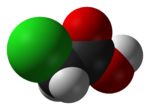This is an old revision of this page, as edited by CheMoBot (talk | contribs) at 17:59, 5 December 2011 (Updating {{chembox}} (changes to watched fields - updated 'DrugBank_Ref') per Chem/Drugbox validation (report errors or bugs)). The present address (URL) is a permanent link to this revision, which may differ significantly from the current revision.
Revision as of 17:59, 5 December 2011 by CheMoBot (talk | contribs) (Updating {{chembox}} (changes to watched fields - updated 'DrugBank_Ref') per Chem/Drugbox validation (report errors or bugs))(diff) ← Previous revision | Latest revision (diff) | Newer revision → (diff)
| |

| |
| Names | |
|---|---|
| IUPAC name Chloroacetic acid | |
| Systematic IUPAC name Chloroethanoic acid | |
| Identifiers | |
| CAS Number | |
| 3D model (JSmol) | |
| ChEBI | |
| ChEMBL | |
| ChemSpider | |
| ECHA InfoCard | 100.001.072 |
| KEGG | |
| RTECS number |
|
| UNII | |
| CompTox Dashboard (EPA) | |
InChI
| |
SMILES
| |
| Properties | |
| Chemical formula | C2H3ClO2 |
| Molar mass | 94.49 g·mol |
| Appearance | Colorless or white crystals |
| Density | 1.58 g·cm, solid |
| Melting point | 63 °C (145 °F; 336 K) |
| Boiling point | 189.3 °C, 462.5 K, 372.7 °F |
| Solubility in water | 85.8 g/100mL (25 °C) |
| Acidity (pKa) | 2.86 |
| Hazards | |
| Occupational safety and health (OHS/OSH): | |
| Main hazards | alkylating agent |
| NFPA 704 (fire diamond) |
 |
| Flash point | 126 °C |
| Related compounds | |
| Except where otherwise noted, data are given for materials in their standard state (at 25 °C , 100 kPa).
| |
Chloroacetic acid, industrially known as monochloroacetic acid (MCA) is the organochlorine compound with the formula ClCH2CO2H. This carboxylic acid is a useful building-block in organic synthesis.
Production
The production of chloroacetic acid was 706,000 tonnes/year in 2010, of which over half is produced in China. Other countries with significant production capacity are Germany (105,000), the Netherlands (100,000), India (>65,000), and the United States (55,000). The world's largest producer is Akzo Nobel.
Processes
Chloroacetic acid is prepared industrially via two routes. The predominant method involves chlorination of acetic acid:
- CH
3CO
2H + Cl
2 → ClCH
2CO
2H + HCl
Acetic anhydride serves as a catalyst for this reaction.
The other main industrial route to chloroacetic acid is hydrolysis of trichloroethylene using sulfuric acid as a catalyst.
- CCl
2CHCl + 2 H
2O → ClCH
2CO
2H + 2 HCl
The hydrolysis method produces a highly pure product, which can be important since mono-, di-, and trichloroacetic acids are difficult to separate by distillation. Approximately, 420,000,000 kg/y are produced globally.
Reactivity and uses
Illustrative of its usefulness in organic chemistry is the O-alkylation of salicylaldehyde with chloroacetic acid, followed by decarboxylation of the resulting ether, producing benzofuran.
In industry, chloroacetic acid is used in the production of a wide variety of useful compounds; e.g., drugs, dyes, pesticides. Most reactions taking advantage of the high reactivity of the C–Cl bond. It is the precursor to the herbicide glyphosate. The herbicides MCPA (2-methyl-4-chlorophenoxyacetic acid) and dimethoate are prepared by alkylation with chloroacetic acid. Chloroacetic acid is converted to chloroacetyl chloride, a precursor to adrenaline (epinephrine). Displacement of chloride by sulfide gives thioglycolic acid, which is used as a stabilizer in PVC and a component in some cosmetics.
In its largest-scale application, chloroacetic acid is used to prepare the thickening agent carboxymethyl cellulose and carboxymethyl starch.
Safety
Like other chloroacetic acids and related halocarbons, chloroacetic acid is a potentially dangerous alkylating agent. The LD50 for rats is 76 mg/kg.
Chloroacetic acid easily penetrates skin and mucous membranes and interferes with cellular energy production. Initial dermal exposure to high concentrations (e.g., 80% solution) may not appear very damaging at first, however systemic poisoning may present within hours. Exposure can be fatal if greater than 6% body surface area is exposed to chloroacetic acid. The sodium salt does not penetrate the skin as well as the acid but can be as damaging given a longer duration and greater surface area of exposure.
Upon one's exposure to chloroacetic acid, immediate decontamination should be commenced by rinsing the affected area with water or bicarbonate solution in order to neutralize the acid and prevent further skin absorption.
The antidote of chloroacetic acid poisoning is sodium dichloroacetate (50 mg/kg IV over 10 mins, repeated in 2h; double dosage if hemodialysis is performed).
See also
References
- Dippy, J.F.J., Hughes, S.R.C., Rozanski, A., J. Chem Soc., 1959, 2492.
- ^ M.P. Malveda (july 2011). "CEH Marketing Research Report: MONOCHLOROACETIC ACID". Chemical Economics Handbook. SRI consulting. Retrieved July 2011.
{{cite web}}: Check date values in:|accessdate=and|date=(help) - ^ Günter Koenig, Elmar Lohmar, Norbert Rupprich "Chloroacetic Acids" in Ullmann's Encyclopedia of Industrial Chemistry 2002, Wiley-VCH, Weinheim. doi:10.1002/14356007.a06_537
- Burgstahler, A. W.; Worden, L. R. (1966). "Coumarone." Org. Synth. 46: 28.
External links
- "Monochloroacetic Acid". Dow Chemical. Retrieved 20 May 2007.
- "Monochloroacetic Acid". IPCS Inchem. Retrieved 20 May 2007.
Categories: